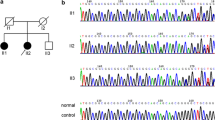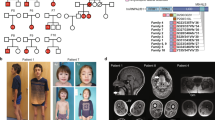Abstract
It has been 10 years since the identification of the first PABPN1 gene (GCN)n/polyalanine mutations responsible for oculopharyngeal muscular dystrophy (OPMD). These mutations have been found in most cases of OPMD diagnosed in more than 35 countries. Sequence analyses have shown that such mutations have occurred numerous times in human history. Although PABPN1 was found early on to be a component of the classic filamentous intranuclear inclusions (INIs), mRNA and other proteins also have been found to coaggregate in the INIs. It is still unclear if the INIs play a pathologic or a protective role. The generation of numerous cell and animal models of OPMD has led to greater insight into its complex molecular pathophysiology and identified the first candidate therapeutic molecules. This paper reviews basic and clinical research on OPMD, with special emphasis on recent developments in the understanding of its pathophysiology.
Similar content being viewed by others
References and Recommended Reading
Victor M, Hayes R, Adams RD: Oculopharyngeal muscular dystrophy: a familial disease of late life characterized by dysphagia and progressive ptosis of the eyelids. N Engl J Med 1962, 267:1267–1272.
Tomé FM, Fardeau M: Nuclear inclusions in oculopharyngeal muscular dystrophy. Acta Neuropathol 1980, 49:85–87.
Brais B, Bouchard JP, Xie YG, et al.: Short GCG expansions in the PABP2 gene cause oculopharyngeal muscular dystrophy. Nat Genet 1998, 18:164–167.
Brais B, Xie YG, Sanson M, et al.: The oculopharyngeal muscular dystrophy locus maps to the region of the cardiac alpha and beta myosin heavy chain genes on chromosome 14q11.2–q13. Hum Mol Genet 1995, 4:429–434.
Bouchard JP, Brais B, Brunet D, et al.: Recent studies on oculopharyngeal muscular dystrophy in Quebec. Neuromuscul Disord 1997, 7(Suppl 1):S22–S29.
Becher MW, Morrison L, Davis LE, et al.: Oculopharyngeal muscular dystrophy in Hispanic New Mexicans. JAMA 2001, 286:2437–2440.
Duranceau A, Forand MD, Fauteux JP: Surgery in oculopharyngeal muscular dystrophy. Am J Surg 1980, 139:33–39.
Tomé FM, Chateau D, Helbling-Leclerc A, et al.: Morphological changes in muscle fibers in oculopharyngeal muscular dystrophy. Neuromuscul Disord 1997, 7(Suppl 1):S63–S69.
Blumen SC, Brais B, Korczyn AD, et al.: Homozygotes for oculopharyngeal muscular dystrophy have a severe form of the disease. Ann Neurol 1999, 46:115–118.
Calado A, Carmo-Fonseca M: Localization of poly(A)-binding protein 2 (PABP2) in nuclear speckles is independent of import into the nucleus and requires binding to poly(A) RNA. J Cell Sci 2000, 113(Pt 12):2309–2318.
Uyama E, Tsukahara T, Goto K, et al.: Nuclear accumulation of expanded PABP2 gene product in oculopharyngeal muscular dystrophy. Muscle Nerve 2000, 23:1549–1554.
Becher MW, Kotzuk JA, Davis LE, et al.: Intranuclear inclusions in oculopharyngeal muscular dystrophy contain poly(A) binding protein 2. Ann Neurol 2000, 48:812–815.
Abu-Baker A, Messaed C, Laganiere J, et al.: Involvement of the ubiquitin-proteasome pathway and molecular chaperones in oculopharyngeal muscular dystrophy. Hum Mol Genet 2003, 12:2609–2623.
Bao YP, Cook LJ, O’Donovan D, et al.: Mammalian, yeast, bacterial, and chemical chaperones reduce aggregate formation and death in a cell model of oculopharyngeal muscular dystrophy. J Biol Chem 2002, 277:12263–12269.
Calado A, Tomé FM, Brais B, et al.: Nuclear inclusions in oculopharyngeal muscular dystrophy consist of poly(A) binding protein 2 aggregates which sequester poly(A) RNA. Hum Mol Genet 2000, 9:2321–2328.
Kim YJ, Noguchi S, Hayashi YK, et al.: The product of an oculopharyngeal muscular dystrophy gene, poly(A)-binding protein 2, interacts with SKIP and stimulates muscle-specific gene expression. Hum Mol Genet 2001, 10:1129–1139.
Corbeil-Girard LP, Klein AF, Sasseville AM, et al.: PABPN1 overexpression leads to upregulation of genes encoding nuclear proteins that are sequestered in oculopharyngeal muscular dystrophy nuclear inclusions. Neurobiol Dis 2005, 18:551–567.
Robinson DO, Wills AJ, Hammans SR, et al.: Oculopharyngeal muscular dystrophy: a point mutation which mimics the effect of the PABPN1 gene triplet repeat expansion mutation. J Med Genet 2006, 43:267–271.
Nakamoto M, Nakano S, Kawashima S, et al.: Unequal crossing-over in unique PABP2 mutations in Japanese patients: a possible cause of oculopharyngeal muscular dystrophy. Arch Neurol 2002, 59:474–477.
Gurtler N, Plasilova M, Podvinec M, et al.: A de novo PABPN1 germline mutation in a patient with oculopharyngeal muscular dystrophy. Laryngoscope 2006, 116:111–114.
Tremolizzo L, Galbussera A, Tagliabue E, et al.: An apparently sporadic case of oculopharyngeal muscular dystrophy: the first Italian report. Neurol Sci 2007, 28:339–341.
Hebbar S, Webberley MJ, Lunt P, et al.: Siblings with recessive oculopharyngeal muscular dystrophy. Neuromuscul Disord 2007, 17:254–257.
Semmler A, Kress W, Vielhaber S, et al.: Variability of the recessive oculopharyngeal muscular dystrophy phenotype. Muscle Nerve 2007, 35:681–684.
Messaed C, Dion PA, Abu-Baker A: et al.: Soluble expanded PABPN1 promotes cell death in oculopharyngeal muscular dystrophy. Neurobiol Dis 2007, 26:546–557.
Kuhn U, Wahle E: Structure and function of poly(A) binding proteins. Biochim Biophys Acta 2004, 1678:67–84.
Bear DG, Fomproix N, Soop T, et al.: Nuclear poly(A)-binding protein PABPN1 is associated with RNA polymerase II during transcription and accompanies the released transcript to the nuclear pore. Exp Cell Res 2003, 286:332–344.
Calado A, Kutay U, Kuhn U, et al.: Deciphering the cellular pathway for transport of poly(A)-binding protein II. RNA 2000, 6:245–256.
Lodderstedt G, Hess S, Hause G, et al.: Effect of oculopharyngeal muscular dystrophy-associated extension of seven alanines on the fibrillation properties of the N-terminal domain of PABPN1. FEBS J 2007, 274:346–355.
Lodderstedt G, Sachs R, Faust J, et al.: Hofmeister salts and potential therapeutic compounds accelerate in vitro fibril formation of the N-terminal domain of PABPN1 containing a disease-causing alanine extension. Biochemistry 2008, 47:2181–2189.
Rohrberg J, Sachs R, Lodderstedt G, et al.: Monitoring fibril formation of the N-terminal domain of PABPN1 carrying an alanine repeat by tryptophan fluorescence and real-time NMR. FEBS Lett 2008, 582:1587–1592.
Sackewitz M, Scheidt HA, Lodderstedt G, et al.: Structural and dynamical characterization of fibrils from a disease-associated alanine expansion domain using proteolysis and solid-state NMR spectroscopy. J Am Chem Soc 2008, 130:7172–7173.
Sackewitz M, von Einem S, Hause G, et al.: A folded and functional protein domain in an amyloid-like fibril. Protein Sci 2008, 17:1044–1054.
Davies J, Wang L, Garcia-Oroz L, et al.: Doxycycline attenuates and delays toxicity of the oculopharyngeal muscular dystrophy mutation in transgenic mice. Nat Med 2005, 6:672–677.
Davies JE, Sarkar S, Rubinsztein DC: Trehalose reduces aggregate formation and delays pathology in a transgenic mouse model of oculopharyngeal muscular dystrophy. Hum Mol Genet 2006, 15:23–31.
Ge H, Zhou D, Tong S, et al.: Crystal structure and possible dimerization of the single RRM of human PABPN1. Proteins 2008, 71:1539–1545.
Bao YP, Sarkar S, Uyama E, et al.: Congo red, doxycycline, and HSP70 overexpression reduce aggregate formation and cell death in cell models of oculopharyngeal muscular dystrophy. J Med Genet 2004, 41:47–51.
Hino H, Araki K, Uyama E, et al.: Myopathy phenotype in transgenic mice expressing mutated PABPN1 as a model of oculopharyngeal muscular dystrophy. Hum Mol Genet 2004, 13:181–190.
Ravikumar B, Duden R, Rubinsztein DC: Aggregate-prone proteins with polyglutamine and polyalanine expansions are degraded by autophagy. Hum Mol Genet 2002, 11:1107–1117.
Catoire H, Pasco MY, Abu-Baker A, et al.: Sirtuin inhibition protects from the polyalanine muscular dystrophy protein PABPN1. Hum Mol Genet 2008, 17:2108–2117.
Chartier A, Benoit B, Simonelig M: A Drosophila model of oculopharyngeal muscular dystrophy reveals intrinsic toxicity of PABPN1. EMBO J 2006, 25:2253–2262.
Wang Q, Mosser DD, Bag J: Induction of HSP70 expression and recruitment of HSC70 and HSP70 in the nucleus reduce aggregation of a polyalanine expansion mutant of PABPN1 in HeLa cells. Hum Mol Genet 2005, 14:3673–3684.
Verheesen P, de Kluijver A, van Koningsbruggen S, et al.: Prevention of oculopharyngeal muscular dystrophy-associated aggregation of nuclear polyA-binding protein with a single-domain intracellular antibody. Hum Mol Genet 2006, 15:105–111.
Berciano MT, Villagra NT, Ojeda JL, et al.: Oculopharyngeal muscular dystrophy-like nuclear inclusions are present in normal magnocellular neurosecretory neurons of the hypothalamus. Hum Mol Genet 2004, 13:829–838.
Villagra NT, Bengoechea R, Vaque JP, et al.: Nuclear compartmentalization and dynamics of the poly(A)-binding protein nuclear 1 (PABPN1) inclusions in supraoptic neurons under physiological and osmotic stress conditions. Mol Cell Neurosci 2008, 37:622–633.
Davies JE, Sarkar S, Rubinsztein DC: Wild-type PABPN1 is anti-apoptotic and reduces toxicity of the oculopharyngeal muscular dystrophy mutation. Hum Mol Genet 2008, 17:1097–1108.
Klein AF, Ebihara M, Alexander C, et al.: PABPN1 polyalanine tract deletion and long expansions modify its aggregation pattern and expression. Exp Cell Res 2008, 314:1652–1666.
Pellerin HG, Nicole PC, Trepanier CA, et al.: Postoperative complications in patients with oculopharyngeal muscular dystrophy: a retrospective study. Can J Anaesth 2007, 54:361–365.
Mathieu J, Lapointe G, Brassard A, et al.: A pilot study on upper esophageal sphincter dilatation for the treatment of dysphagia in patients with oculopharyngeal muscular dystrophy. Neuromuscul Disord 1997, 7:S100–S104.
Hill ME, Creed GA, McMullan TF, et al.: Oculopharyngeal muscular dystrophy: phenotypic and genotypic studies in a UK population. Brain 2001, 124(Pt 3):522–526.
Author information
Authors and Affiliations
Corresponding author
Rights and permissions
About this article
Cite this article
Brais, B. Oculopharyngeal muscular dystrophy: A polyalanine myopathy. Curr Neurol Neurosci Rep 9, 76–82 (2009). https://doi.org/10.1007/s11910-009-0012-y
Published:
Issue Date:
DOI: https://doi.org/10.1007/s11910-009-0012-y




